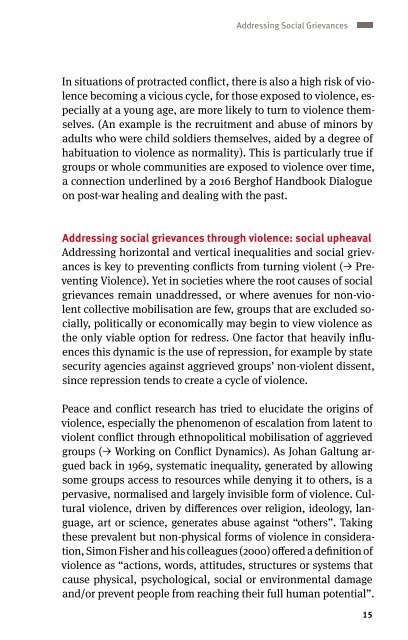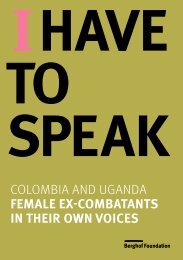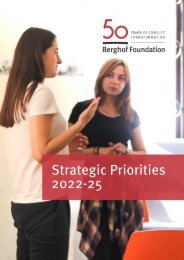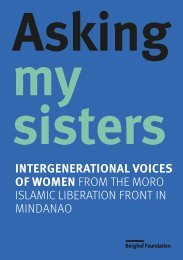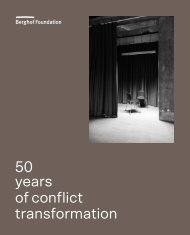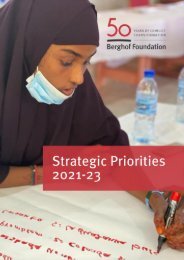Berghof Glossary on Conflict Transformation
The Berghof Glossary on Conflict Transformation presents 20 of the main principles and approaches used by the Berghof Foundation in its work. It is a concise and accessible exploration of what it takes to create “space for conflict transformation”. 2019 edition.
The Berghof Glossary on Conflict Transformation presents 20 of the main principles and approaches used by the Berghof Foundation in its work. It is a concise and accessible exploration of what it takes to create “space for conflict transformation”. 2019 edition.
You also want an ePaper? Increase the reach of your titles
YUMPU automatically turns print PDFs into web optimized ePapers that Google loves.
Addressing Social Grievances<br />
In situati<strong>on</strong>s of protracted c<strong>on</strong>flict, there is also a high risk of violence<br />
becoming a vicious cycle, for those exposed to violence, especially<br />
at a young age, are more likely to turn to violence themselves.<br />
(An example is the recruitment and abuse of minors by<br />
adults who were child soldiers themselves, aided by a degree of<br />
habituati<strong>on</strong> to violence as normality). This is particularly true if<br />
groups or whole communities are exposed to violence over time,<br />
a c<strong>on</strong>necti<strong>on</strong> underlined by a 2016 <str<strong>on</strong>g>Berghof</str<strong>on</strong>g> Handbook Dialogue<br />
<strong>on</strong> post-war healing and dealing with the past.<br />
Addressing social grievances through violence: social upheaval<br />
Addressing horiz<strong>on</strong>tal and vertical inequalities and social grievances<br />
is key to preventing c<strong>on</strong>flicts from turning violent (→ Preventing<br />
Violence). Yet in societies where the root causes of social<br />
grievances remain unaddressed, or where avenues for n<strong>on</strong>-violent<br />
collective mobilisati<strong>on</strong> are few, groups that are excluded socially,<br />
politically or ec<strong>on</strong>omically may begin to view violence as<br />
the <strong>on</strong>ly viable opti<strong>on</strong> for redress. One factor that heavily influences<br />
this dynamic is the use of repressi<strong>on</strong>, for example by state<br />
security agencies against aggrieved groups’ n<strong>on</strong>-violent dissent,<br />
since repressi<strong>on</strong> tends to create a cycle of violence.<br />
Peace and c<strong>on</strong>flict research has tried to elucidate the origins of<br />
violence, especially the phenomen<strong>on</strong> of escalati<strong>on</strong> from latent to<br />
violent c<strong>on</strong>flict through ethnopolitical mobilisati<strong>on</strong> of aggrieved<br />
groups (→ Working <strong>on</strong> C<strong>on</strong>flict Dynamics). As Johan Galtung argued<br />
back in 1969, systematic inequality, generated by allowing<br />
some groups access to resources while denying it to others, is a<br />
pervasive, normalised and largely invisible form of violence. Cultural<br />
violence, driven by differences over religi<strong>on</strong>, ideology, language,<br />
art or science, generates abuse against “others”. Taking<br />
these prevalent but n<strong>on</strong>-physical forms of violence in c<strong>on</strong>siderati<strong>on</strong>,<br />
Sim<strong>on</strong> Fisher and his colleagues (2000) offered a definiti<strong>on</strong> of<br />
violence as “acti<strong>on</strong>s, words, attitudes, structures or systems that<br />
cause physical, psychological, social or envir<strong>on</strong>mental damage<br />
and/or prevent people from reaching their full human potential”.<br />
15


